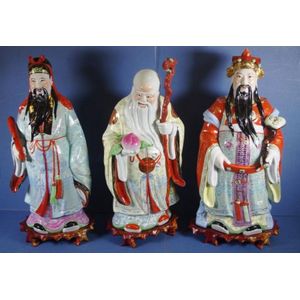Georgian Staffordshire Figures of Juno and Jupiter
A pair of Georgian Staffordshire figures of 'Juno' and 'Jupiter', circa 1820, the pearlware allegorical figures modelled in the round standing on square bases, holding and accompanied by their respective attributes, Jupiter with a lightning bolt and an eagle, Juno accompanied by her sacred peacock, height 16 cm, and smaller
You must be a subscriber, and be logged in to view price and dealer details.
Subscribe Now to view actual auction price for this item
When you subscribe, you have the option of setting the currency in which to display prices to $Au, $US, $NZ or Stg.
This item has been sold, and the description, image and price are for reference purposes only.
- Georgian - As an English stylistic period, Georgian is usually taken to cover the period from George I (1714) to the Regency of Prince George (1811-20), although the period from 1800 to 1830 is sometimes designated as the Regency period. During the Georgian period the great English cabinetmakers and designers such as Chippendale, Hepplewhite, Adam Sheraton etc., were all active.
Therefore there isn't a single 'Georgian style' as such and to say something is 'Georgian', usually means it was made between 1714 and 1830. This assumes we discount George V and George VI, both being from the 20th century.
The styles popular at the time of each reign were:
George I (1714-1727) saw out the last years of the Baroque period.
George II (1727-1760) reigned during the Rococo period.
George III (1760-1820) saw the last gasp of the Rococo, all of the early Neo-Classic 'Adam style' and most of the later neo-Classic 'Regency style'.
George IV (Prince Regent 1820-1830)encompassed the last of the 'Regency' style.
William IV's reign (1830-1837) was something of a no man's land (stylistically) and he wasn't a 'George' anyway. He covered the last glimmerings of 'Regency' and the start of the 'Victorian' style. - Pearlware - Pearlware is a type of earthenware pottery that was developed in the late 18th century in England, made from a mixture of clay, flint, and other materials, and is distinguished by its smooth, creamy white glaze. The glaze has a pearlescent quality, which is how the pottery got its name.
Pearlware was developed as a more affordable alternative to porcelain, which was much more expensive and difficult to produce. It quickly became popular throughout England and Europe, and was exported to other parts of the world as well. It was particularly popular for making tableware, such as plates, bowls, and teapots, as well as decorative objects like figurines and vases.
One of the most distinctive features of pearlware is its blue decoration. Many pieces of pearlware were decorated with blue patterns or designs, often featuring pastoral scenes, floral motifs, or geometric patterns. The blue decoration was typically applied over the white glaze, which created a striking contrast and made the designs stand out. - Circa - A Latin term meaning 'about', often used in the antique trade to give an approximate date for the piece, usually considered to be five years on either side of the circa year. Thus, circa 1900 means the piece was made about 1900, probably between 1895 and 1905. The expression is sometimes abbreviated to c.1900.
This item has been included into following indexes:
Visually similar items

Two various Royal Doulton figures, including 'Sarah,' HN3380 (Certificate available), and 'Wintertime,' HN3060, height 23 cm (taller).
Sold by
in
for
You can display prices in $Au, $US, $NZ or Stg.

Two Victorian bisque lady figurines H42 cm approx (tallest)
Sold by
in
for
You can display prices in $Au, $US, $NZ or Stg.

A Royal Doulton 'Kirsty' figurine (dark pink)
Sold by
in
for
You can display prices in $Au, $US, $NZ or Stg.

Set three Chinese large ceramic sage figures, three immortals, decorated in polychrome colours. Each on a carved wood stand. Height 80 cm (tallest).
Sold by
in
for
You can display prices in $Au, $US, $NZ or Stg.
